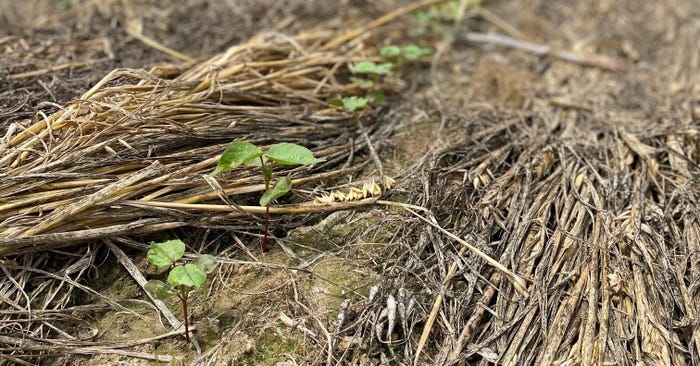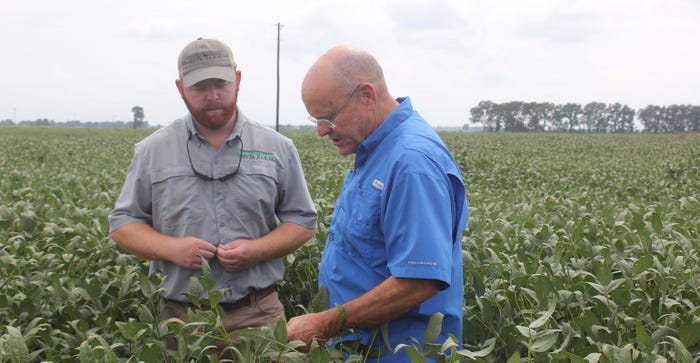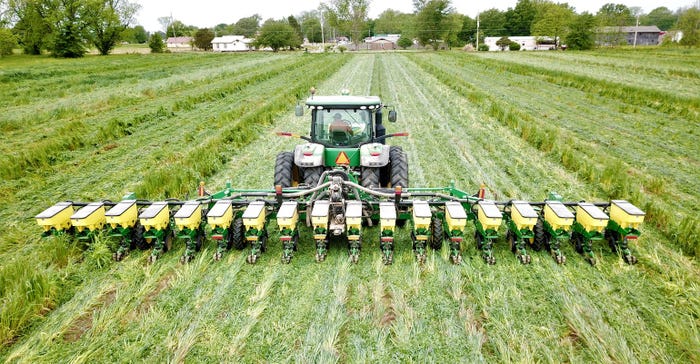
Steve Skelton, a row crop farmer near Shaw, Miss., has been experimenting with cover crops and minimum tillage for the past five seasons. He shares the key steps he’s learned to making this system work in the Mississippi Delta. Ginger Rowsey
Long before terms like “climate change” and “regenerative agriculture” became part of the mainstream lexicon, Steve Skelton was working with cover crops on the family farm in Shaw, Miss.
“When I was growing up in the 1970s, my dad planted cover crops” Skelton recalls. “We really liked what we saw, but in hindsight, we were missing some key tools that could have made covers a better fit. One of the main ones was GPS guidance. When you have green stuff two-to-three feet tall, you can’t see your rows to plant.”
Cover crops fell out of the rotation on their Mississippi Delta farm. But in 2017, armed with 21st century technology, Skelton decided to give the practice another try.
Over the past five years, he’s planted different varieties. Tested different planting methods and termination timings. And admits to experiencing different degrees of success. (GPS made it easier to plant rows in green cover, but it did nothing for vetch in the trash wheels.)
Still, he’s pleased with cover crops. They are now planted on most of his acres each fall.
Skelton is among a growing number of producers in the Mississippi Delta region who are increasing their use of cover crops and minimal tillage.
“I think we’re still figuring out what we can and can’t do with cover crops and a minimal tillage system in the Delta, but overall, it has been a good experience,” he said.

“It may be too early to document results, but I do think we are getting better water infiltration. I think the mulch that the cover crop gives helps retain moisture,” he said.
“Mostly, I think it’s the right thing to do for the soil and environment.”
Improving water quality
Skelton’s farm lies in the Porter Bayou Watershed, an area targeted for nutrient reduction strategies by the Mississippi Department of Environmental Quality. As natural resource agencies and local farmers looked for practical, cost-effective ways to reduce nutrient losses, cover crops rose to the top.
“We’ve found cover crops paired with a minimal tillage system are the best improvements for erosion and runoff,” said Parker Frew, program manager with Delta F.A.R.M. “This system can slow the velocity of runoff from rainfall and prevent leaching by storing nutrients in the cover crop until the following year’s crop can use them.”
Delta F.A.R.M. or Delta Farmers Advocating Resource Management is an association of growers and landowners that formed in 1998 to address growing natural resource concerns. Farmers who join the program are assisted in implementing conservation practices in their operations. More than 1.2 million acres in northwestern Mississippi are currently enrolled.
In 2018, Delta F.A.R.M. teamed with EPA and USDA to evaluate the impact of cover crops and minimal tillage on water quality. Data from 90 water samples collected over 20 rain events showed the cover crop-minimal tillage system reduced nutrient loading in surface runoff by 33% compared to the control.

“As far as water quality goes, we know it’s a home run,” Frew said. “We just have to make sure we can remain profitable and reduce risk, while using this system.”
Delta cover crop acres increasing
While cover crops have been a hot topic for years, as recently as 2017 the U.S. Census of Agriculture reported only 2.3% of crop acres in the Mississippi Delta region were planted to cover during the off-season. That’s quickly changing, according to Frew
“Seeing just the two-year difference in cover crop adoption for our region is amazing,” Frew said. “I have people that I thought two years ago would never call me about cover crops that are doing their whole farm in them this year.”
Delta F.A.R.M. tracks the adoption of more than 50 conservation practices. From 2019 to 2021, the percentage of Delta F.A.R.M. participants planting cover crops grew from 30% to 63%, according to the organization’s environmental stewardship reports.
Frew said that amounts to more than 30,000 acres of additional cover crops in the two-year period.
“When I first got here, Delta F.A.R.M. was only doing a few hundred acres of cover crop. Now we’re doing thousands and thousands of acres,” he said.

It’s no secret subsidies help conservation get placed on the landscape. In January Mississippi was one of 11 states selected for the initial pilot of the EQIP Cover Crop Initiative — a $38 million investment in cover crop support. Producers can receive anywhere from $50-$70 per acre to help offset the cost of cover crops. That most likely contributed to the accelerated rate of adoption.
This fall, Frew expects Mississippi growers to plant the largest number of cover crop acres ever.
“Of course, it fluctuates with funding, but I think we’ll see continued growth in adoption in the next few years. People are starting to see the need for change.”
Barriers to entry
Despite increased conservation incentives, shifting from fall burndown and subsoil tilling to a cover crop-minimal till system comes with a learning curve, and returns on investment are not immediate.
A two-year study by Mississippi State University that compared cover crop and minimal till to conventional systems in large scale fields in the Delta found that the cover crops-minimal till system had no effect on yield and averaged a net loss of roughly $94 per acre, over the first two years. However, it is important to note that the study took place in 2018-2019. Economic analysis was based on average grain prices for those two years (corn $3.85/bu; soybeans $8.95/bu.).
“These results reflect the short study period as changes resulting from these practices often occur on a greater time scale,” the authors of the study wrote.

Still, that could be a tough sell for growers. However, those who have bought in to conservation practices say they are seeing intangible benefits that this study didn’t measure.
“Microbial activity is through the roof on cover crops. Where we’ve switched to minimal tillage, earthworms are thriving now, where we would never see them before. So, we know changes are happening in the soil,” Skelton said.
“I think if farmers really keep up with costs, they’ll figure out that cover crop paired with minimal till will more than pay for itself with reduced tillage, reduced equipment costs, reduced labor, and fuel savings,” Skelton said. “I think they’ll like what they see.”
“There are so many benefits environmentally, and I think if we can at least break even or make a little money doing it, it’s the thing to do.”
Making cover crops work
So, how has Skelton made cover crops work on his farm?
“One of the keys to making cover crops work in the Delta is get them planted early, get a good stand, and get that active root development,” Skelton said. As a strictly grain producer, he typically plants cover crops the last week of September or first of October.

Skelton has tried several different planting methods — broadcast, as well as drilled on 7.5- and 15-inch spacings.
“I like 15-inch spacing. You can position the drill so that the seed zone where you will plant the cash crop is between the cover crop,” he said. “Especially for corn, it is important to have a clean area for seed emergence.”
The next key factor — terminate early.
“The later I wait to terminate, the more issues I have. It seems like we have a tighter and tighter window to get planted in a timely fashion and then to try to get fertilizer and everything else out. Cover crop can impede that if you delay termination,” he said.
Skelton said terminating cover crops three weeks prior to planting is ideal for his farm.
“You could go a little later with soybeans but may need to terminate a little earlier before planting corn,” he added.
He’s also learned to worry less when crops planted behind cover don’t jump out of the ground as quickly as crops planted using conventional methods.
“We saw a lag early in the season this year with cover crop versus conventional, but as time progressed, the soybeans behind cover crops caught up and even looked better. As we get the combine in the field, we’ll know for sure which system won,” Skelton said.
Another piece of advice — communicate with neighbors. Many may still be doing mid-winter burndowns. Let them know where cover crops are planted to avoid drift issues.
And finally, don’t be afraid to get started.
“Be cautious and go slow. But at the same time don’t be scared,” he said. “To try something new requires different thinking.”
About the Author(s)
You May Also Like






